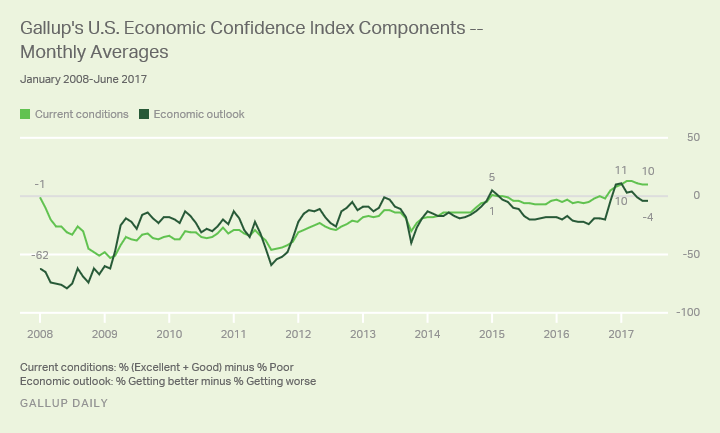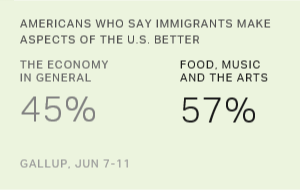Story Highlights
- Economic Confidence Index registers +3 for second straight month
- Economic attitudes stable across all political identifications
- Current conditions component at +10; economic outlook at -4
WASHINGTON, D.C. -- Americans' confidence in the economy remained at a 2017 low in June, with Gallup's U.S. Economic Confidence Index averaging +3 for the second month in a row. Despite confidence lagging below January's monthly record high of +11, June nonetheless marked the eighth consecutive month in which U.S. adults rated the economy positively.

Gallup's U.S. Economic Confidence Index is the average of two components: how Americans rate current economic conditions and whether they believe the economy is improving or getting worse. The index has a theoretical maximum of +100 if all Americans were to say the economy is doing well and improving, and a theoretical minimum of -100 if all were to say the economy is doing poorly and getting worse.
Last week, Americans' confidence in the economy averaged a score of 0, the first time in the 33 full weeks since the presidential election that the index's weekly average was not positive. However, this may be more of a fluke than a harbinger -- lower scores in the middle of the week dragged down the weekly average. They returned to previous levels by the end of the week.
Gallup began tracking Americans' assessments of the economy in 2008, in the midst of the worst recession in decades. Unsurprisingly, economic attitudes were then decisively negative and only grew worse over the course of 2008, a year that saw several financial firms declare bankruptcy and Wall Street experience huge losses. Perceptions slowly began to improve in 2009 and throughout Barack Obama's presidency, although they remained in negative territory apart from a brief period in early 2015 when gasoline prices showed sustained decreases.
Only after Donald Trump's election in 2016 did economic attitudes fundamentally change, thanks largely to Republicans' newfound optimism. Economic confidence peaked in January 2017, remaining high through March. U.S. stock markets soared during this time, and many analysts believed that some elements of Trump's economic agenda -- such as cutting taxes and increasing spending on infrastructure -- would lead to an era of higher economic growth, although these projections have yet to materialize.
Since March, confidence has softened somewhat, as Democrats and independents have lost faith in the economy. Monthly confidence fell in May to its lowest point of the year, sliding to -26 among Democrats -- the lowest score for that group since November 2011 and a 32-point drop from January 2017. Confidence among independents, meanwhile, fell eight points between January and May.
In June, attitudes stabilized. Economic confidence among Democrats stood at -28, in line with where it was the month before. Likewise, independents' confidence in the economy was essentially unchanged last month (-4) compared with May (-3).
More Americans Still See Economy as Getting Worse Rather Than Better
Last month, Americans continued to view current economic conditions positively, with 33% describing the economy as "excellent" or "good" compared with 23% describing it as "poor." This leaves the current conditions component at +10 for June, identical to its performance in May.
For the third month in a row, however, a slightly larger share of Americans (49%) said the economy is "getting worse" than said it is "getting better" (45%). This puts the economic outlook component at -4 in June, in line with its May reading.

Bottom Line
While economic confidence in June remained at the yearly low first reached in May, the apparent stability may suggest that Americans have, after a postelection adjustment period, recalibrated their economic assessments. In particular, some Americans who believed the election results would augur an improving economy have since revised these beliefs, as is evident by the comparatively poor performance of the economic outlook component over the past few months.
All the same, this new level of confidence may offer a baseline for measuring the effects of the Trump administration's economic policies -- failed and successful -- on Americans' perceptions of the economy.
These data are available in Gallup Analytics.
Gallup.com reports results from these indexes in daily, weekly and monthly averages and in Gallup.com stories. Complete trend data are always available to view in the following charts:
Daily: Employment, Economic Confidence, Consumer Spending
Weekly: Employment, Economic Confidence, Job Creation, Consumer Spending
Read more about Gallup's economic measures.
View our economic release schedule.
Survey Methods
Results for this Gallup poll are based on telephone interviews conducted June 1-30, 2017, on the Gallup U.S. Daily survey, with a random sample of 15,224 adults, aged 18 and older, living in all 50 U.S. states and the District of Columbia. For results based on the total sample of national adults, the margin of sampling error is ±1 percentage point at the 95% confidence level. All reported margins of sampling error include computed design effects for weighting.
Each sample of national adults includes a minimum quota of 70% cellphone respondents and 30% landline respondents, with additional minimum quotas by time zone within region. Landline and cellular telephone numbers are selected using random-digit-dial methods.
Learn more about how the Gallup U.S. Daily works.



